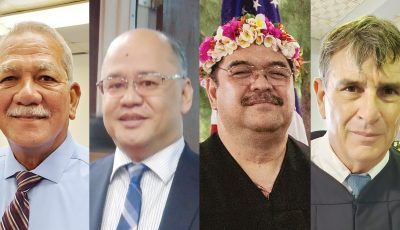AG: 2 votes unconstitutional
Manibusan recommends filing certified question to high court to resolve tie-breaker rule dispute
Attorney General Edward Manibusan has issued an opinion that the House of Representatives’ tie-breaker rule that allows the speaker to vote twice in the event of a tie contravenes the CNMI Constitution’s provision on the minimum vote requirement.
In his opinion last Friday, Manibusan also recommended that due to the importance of resolving the constitutionality of the tie-breaker rule and the likelihood that it will be invoked regularly during the present term, a certified question petition to the Supreme Court to resolve the dispute is a recourse that may be explored.
Manibusan issued the opinion after nine Republican representatives and one independent representative sought last March 25 his legal opinion on Article II Section 3 of the NMI Constitution pertaining to the principle of “one representative, one vote.” The 10 lawmakers said it is their understanding that House Rule XI Section 10 “Tie Vote” may be in contravention to Article II the NMI Constitution.
Last March 19, House Speaker Edmund S. Villagomez (Ind-Saipan) had to exercise his authority to break a 10-10 tie to pass a bill that mandates legislative appropriation for the estimated $515-million Coronavirus State Fiscal Recovery Fund that will be allocated to the CNMI.
When asked for comments yesterday, Villagomez said that he has not seen the AG’s opinion yet.
Manibusan said they framed the question as whether House Rule XI, section 10 is constitutional.
Manibusan said that, based on their review of the pertinent sections of the Constitution, the 1976 Analysis, and the House Rules of Procedure, he has “reservations” that the tie-breaker rule of having the speaker vote twice during a session in the event of a tie on the final approval of a bill is constitutional.
He said Section 5(c) of Article XII of the Constitution requires a bill to be approved by “at least a majority of the votes cast in” each house of the Legislature.
“This is the threshold number of votes needed to approve a bill,” Manibusan pointed out, adding that if the vote falls short of the majority of votes cast, the bill does not pass the House floor for transmittal to the Senate.
He said the House failed to muster the majority of the votes necessary to approve the bill.
The AG said Section 5(c) of Article II of the Constitution states that “the legislature may not enact a law except by bill and no bill may be enacted without the approval of at least a majority of the votes cast in each house of legislature.”
He said the 1976 Analysis of the Commonwealth Constitution sheds light on the intent of the framers in drafting Section 5(c) which has remained unchanged since the original Constitution was approved.
Manibusan said that, based on the Analysis, the framers intended that Section 5(c) be a minimum requirement and that the Senate, or the House, could require a greater margin than the “majority of votes cast.”
For example, the AG said, a higher voting requirement could be based on a majority of the members of the Senate or the House; or a majority of the members present at a session. “Both scenarios would increase the number of votes necessary to pass a bill,” he said.
Instead of raising a bar on the number of affirmative votes to pass a bill, Manibusan said House Rule XI, Section 10 creates a tie-breaker rule that “when the vote for or against a proposition are equal, the speaker may cast a second vote to break the tie.” He said the language in the House rule does not state that the speaker’s second vote does not apply to the final disposition of a bill and uses the word “proposition.”
Used only in Section 10 of the House Rules, the word “proposition” as commonly understood means “something offered for consideration: proposal,” Manibusan said.
He said a motion to approve a bill could be encompassed within the broad meaning of proposition and would trigger the speaker’s second vote if he decides to cast an additional vote on a motion to approve a bill.
He said the speaker’s second vote to break a tie contravenes the threshold voting requirement in Section 5(c) that a bill must receive the “majority of votes cast.”
The AG said under Section 5(c), when the casting of votes on the motion to approve a bill fails to garner the minimum threshold of a “majority of votes cast,” the motion is deemed disapproved and the bill does not move past the House floor to be transmitted to the Senate for action.
Unlike the U.S. Senate and other jurisdictions, there is no tie breaker rule provided in Section 5(c) or anywhere else under the CNMI Constitution to get around the threshold of “majority of votes cast,” Manibusan said.
He said the 1976 Analysis makes clear that Section 5(c) is the minimum vote requirement and neither the House, nor the Senate, can circumvent the minimum vote requirement by rule or by statute.
“The only recourse is for either house to raise the vote requirement by using the total number of members of the House or Senate, or by using the total number of members present at the session,” Manibusan said.



























